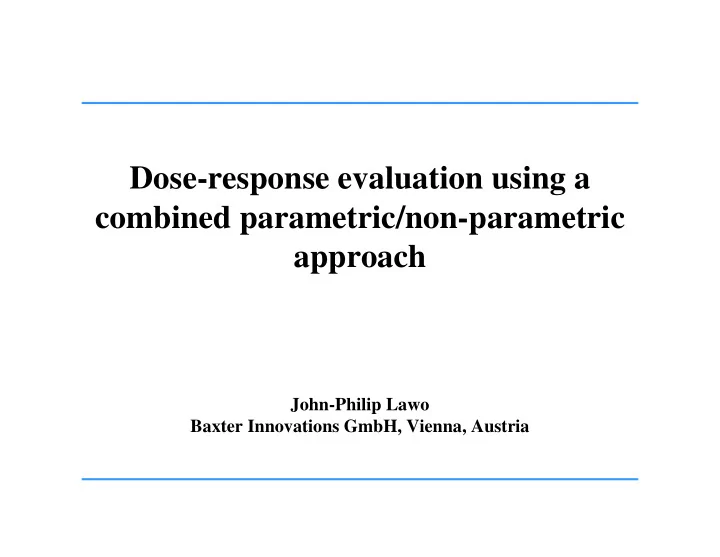

Dose-response evaluation using a combined parametric/non-parametric approach John-Philip Lawo Baxter Innovations GmbH, Vienna, Austria
A Safety Issue: Thrombogenicity Thrombogenicity is a safety aspect for plasma derived VonWillebrand products intended to treat haemophilia (EMEA Guideline CPMP/BPWG/220/02) ‘Wessler score’: • Used to measure thrombogenicity • Based on 7-part ordinal scale (0, 0.5, 1, 2, 3, 3.5, 4), where 0 = no thrombus formation, 4 = high thrombus formation 2008-09-25 John-Philip Lawo, Baxter 2
Essential Part of Drug Development: Dose-response • ICH E4: „Assessment of dose-response should be an integral component of drug development with studies designed to assess dose-response an inherent part of establishing the safety and effectiveness of the drug.“ • The estimated dose to cause 50% effect (ED 50 ) is one characteristic of dose-response relation 2008-09-25 John-Philip Lawo, Baxter 3
Fitting Shapes to Data: The E max -Model h D E ⋅ i max R E = + i 0 h h D ED + i 50 i = subject = response of subject i R i D i = dose level of subject i h = slope factor E 0 = effect at zero-dose E max = maximum effect attributable to the drug 2008-09-25 John-Philip Lawo, Baxter 4
A Simulation Study Frequencies of Wessler scores by dose group were generated using the multinomial distribution Parameters used: • Wessler scores: 0, 0.5, 1, 2, 3, 3.5, 4 • Dose groups: 0, 300, 600, 900, 1200 • Samples per dose group: 3, 6, 10, 100 • True doses of ED 50 : 100, 300, 600, 1200, 1500 � five different shapes were investigated, 10 4 simulation runs were performed 2008-09-25 John-Philip Lawo, Baxter 5
Investigated Dose-response Shapes 2008-09-25 John-Philip Lawo, Baxter 6
Results: Estimation of ED 50 Shape Heavy Right Sigmoid Left skewed Linear right skewed skewed True ED 50 100 300 600 1200 1500 n 0.3% 16.5% -0.93% 1.89% 8.65% 3 (100.3) (349.5) (594.4) (1222.6) (1629.7) 0.2% 5.17% -0.55% 0.77% 3.58% 6 (100.2) (315.5) (596.7) (1209.2) (1553.7) 0.1% 0.63% -0.33% 0.43% 1.83% 10 (100.1) (301.9) (598.0) (1205.2) (1527.5) 0% -0.7% -0.07% 0.03% 0.16% 100 (100.0) (297.9) (599.6) (1200.3) (1502.6) % mean bias (mean estimated value) 2008-09-25 John-Philip Lawo, Baxter 7
Accuracy of ED 50 : Confidence Intervals Calculation of 95% CI for ED 50 according to • Bootstrap-percentile • Bootstrap- t (using SE from non-linear model) • Normal approximation using 10 3 bootstrap resamples Coverage of intervals evaluated by 10 4 simulation runs 2008-09-25 John-Philip Lawo, Baxter 8
Results: Coverage of 95% CI for ED 50 True Bootstrap Normal Shape n Bootstrap-t ED 50 percentile approximation 3 0.8788 0.8831 0.9149 6 0.8940 0.9023 0.9243 Heavy right 100 10 0.9069 0.9306 0.9308 skewed 100 0.9421 0.9451 0.9454 3 0.8067 0.5762 0.6810 6 0.9316 0.7186 0.7460 Right skewed 300 10 0.9551 0.7660 0.7937 100 0.9466 0.9370 0.9396 3 0.7323 0.6899 0.7125 6 0.8935 0.8488 0.8670 Sigmoid 600 10 0.9207 0.8916 0.8952 100 0.9514 0.9192 0.9478 3 0.8573 0.9310 0.9373 Heavy left 6 0.8677 0.8869 0.8918 1200 skewed 10 0.8633 0.9341 0.9198 100 0.9474 0.9463 0.9458 3 0.6471 0.7840 0.6695 6 0.8538 0.8672 0.8695 Linear 1500 10 0.9216 0.8952 0.9043 100 0.9494 0.9461 0.9473 2008-09-25 John-Philip Lawo, Baxter 9
Results: Width of 95% CI for ED 50 True Bootstrap Normal Shape n Bootstrap-t ED 50 percentile approximation 3 30.7 32.2 32.0 Heavy right 6 25.0 25.4 25.3 100 skewed 10 20.8 20.8 20.8 100 7.3 7.3 7.3 3 364.9 547.4 414.9 6 381.3 450.5 398.8 Right skewed 300 10 348.8 383.4 360.6 100 151.2 150.2 150.9 3 184.5 456.4 186.7 6 147.0 32837.1 150.5 Sigmoid 600 10 121.1 120.8 121.9 100 42.3 40.0 42.1 3 341.2 344.5 340.9 Heavy left 6 215.2 207.7 225.1 1200 skewed 10 174.1 176.5 169.3 100 55.6 55.4 55.4 3 2347.6 1747.2 2504.0 6 1211.0 1020.2 1263.2 Linear 1500 10 808.7 808.7 808.7 100 215.1 213.1 214.6 2008-09-25 John-Philip Lawo, Baxter 10
Recommendations Based on Combined Coverage and Width Shape Heavy right Right Sigmoid Left skewed Linear skewed skewed Normal Bootstrap Bootstrap Best coverage Bootstrap- t Bootstrap- t approximation percentile percentile Bootstrap Bootstrap Bootstrap Smallest width Bootstrap- t Bootstrap- t percentile percentile percentile Normal Bootstrap Bootstrap Recommendation Bootstrap- t Bootstrap- t approximation percentile percentile 2008-09-25 John-Philip Lawo, Baxter 11
Pitfalls • Estimation of ED 50 may fail � change starting values • Heavy right skewed data were only estimable with a fixed prespecified slope of 1 2008-09-25 John-Philip Lawo, Baxter 12
Summary • The E max -model can be used for robust estimation of ED 50 • Confidence intervals for ED 50 can be estimated using resampling methods in most cases • Approach can be extended for comparisons of dose- response shapes 2008-09-25 John-Philip Lawo, Baxter 13
References • Davison, A. C. & Hinkley, D. V. (1997) Bootstrap Methods and Their Applications . Cambridge University Press, Cambridge • Ting, N. (Eds.) (2006). Dose Finding in Drug Development . Springer Verlag, 127-145 • Hereen, T. & D’Agustino, R. (1987) Robustness of the two independent sample t-test when applied to ordinal scale data . Statistics in Medicine, 6, 79-90 • Wessler S., Reimer S. M., Steps M. C. (1959): Biologic assay of a thrombosis-inducing activity in human serum . J. Appl. Physiol. 14, 943- 946 • CPMP/BPWG/220/02: Guideline on the clinical investigation of human plasma derived von Willebrand factor products • CPMP/ICH/378/95: Note for guidance on dose response information to support drug registration 2008-09-25 John-Philip Lawo, Baxter 14
Recommend
More recommend